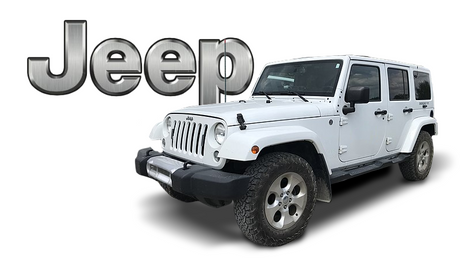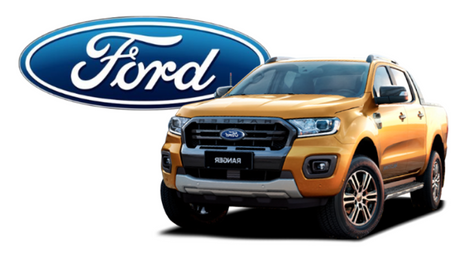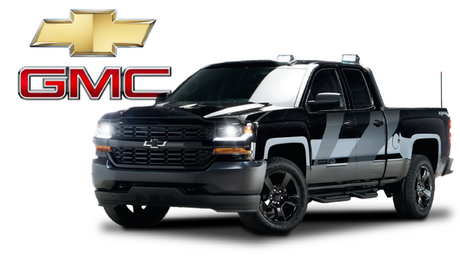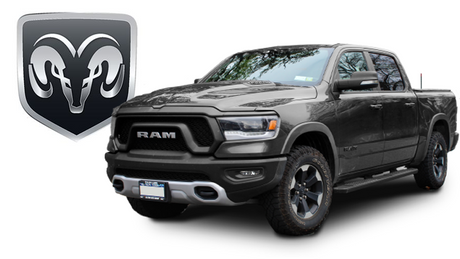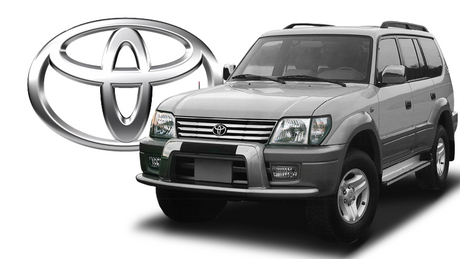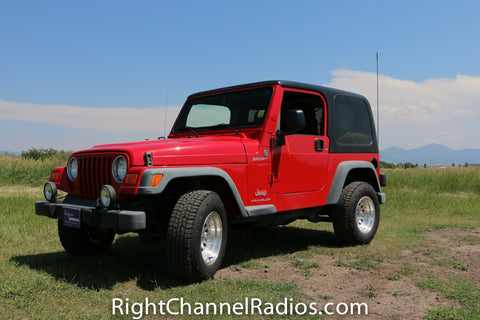
A CB radio is an indispensable tool for any Jeep trail ride. Without one, how are you going to heckle your buddy two vehicles up for the poor line he just took?
Jeeps have some unique requirements compared to other vehicles when it comes to picking a CB radio and antenna setup.
You need heavy-duty equipment that can withstand vibrations and open-air conditions. And, because most Jeeps cabs are on the smaller size, those massive cinderblock-sized radios (well, it seems like it at least) just aren't going to cut it. You need something smaller.
Here at Right Channel Radios, we specialize in Jeep and 4x4 CBs - and know exactly what will work well for your vehicle. We'll cover everything you need to know below.
Table of Contents
- Specific Mounting Locations
- Picking an Antenna for Your Jeep
- Picking a Radio for Your Jeep
- Coax Cable
- Equipment Recommendation Summary
General Antenna Mounting Guidelines
Before we dive into the specifics of Jeep installations, it's good to cover a few universal CB antenna concepts. As a general rule for all antenna installations:- Longer = Better. The longer the antenna, the better performance you'll receive.
- Higher = Better. The higher up you can mount antenna (resulting in the higher its top is), the better performance you'll receive. Ideally you want at least 1/2 of the antenna above the roof line and 1/3 above the roofline at a minimum.
- Higher Quality = Better. It may sounds obvious, but you'll get better performance (both in terms of range potential and longevity) from a well-known, trusted brand. We'll mention our favorites throughout the article.
Mounting to the Tire Carrier
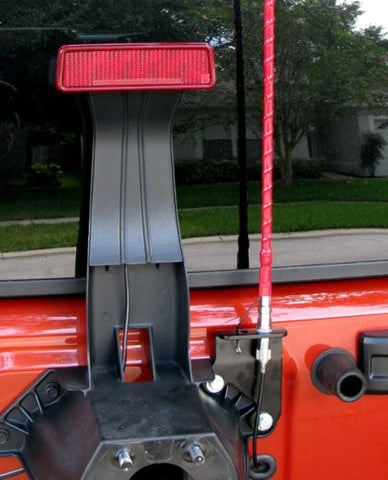
The tire carrier is one of the most popular places to mount an antenna. It's especially an attractive choice for JK Jeeps, as there's a special JK mounting bracket that fits those vehicles perfectly.
If you're mounting to a swing out tire carrier on non-JK models, it's crucial to make sure the tire carrier arm is grounded to the vehicle. Often, the swing hinge prevents the arm from grounding to the vehicle. And without a good ground, your CB antenna simply won't work.
Use a multimeter to make sure there's a solid ground. If not, use some wire or a grounding strap to establish one at the hinge point.
Mounting to the Taillight or Tub Body

Mounting directly to the rear of the Jeep's body / tub is also a popular option. 1987-2006 Jeep models can install a special Jeep Wrangler tail light CB mount, which uses the existing tail light mount holes to secure the mounting platform.
For those who don't mind drilling new holes, a standard 3-way or side mount are also commonly used.
Important: Grounding Powder Coated Mounts
Many of the mounts mentioned above are finished with a black powder coat, which gives them a nice factory finish. However, this coat prevents the antenna from grounding properly. If you don't take the necessary steps to ensure your mount allows your antenna to ground, your CB performance will be abysmal.
Here's what you need to do. Make sure to scrape off the powder coating in two places:
- Next to the mounting bolts, so that that mounting bolts can ground to the mount through metal-to-metal contact
- Above and underneath the stud mounting hole, so that the stud and antenna can ground through the mount and back to the vehicle
Sound confusing? Don't worry. We include steps on how to do this in all our Jeep CB kits and have also included pictures of how this looks below.
Rear Mounting Performance Considerations
Mounting the antenna on the rear of the Jeep - either on the tire carrier, tub or bumper - is probably the most popular location drivers choose. And it's not a bad option! The antenna is out of the way in the back, protected from overhanging brush, and there are a number of vehicle specific mounts for rear mounting.
But you do need to be careful of two things when mounting in the rear.
First, make sure your antenna has a MINIMUM of 1/3 of the length above the roofline. If you don't have at least this much showing, you're likely going to have some noticeable performance issues.
Secondly, be aware that for Jeeps with fiberglass or soft tops there's a greater likelihood of having less than top-notch performance compared to mounting the antenna in the front of the vehicle.
Without getting too technical, CB antennas use a vehicle's metal chassis to send and receive a signal. So when the antenna can't see much metal (as is the case when mounted on the back behind a fiberglass topper), it can't function nearly as well.
We have a lot of Jeep owners who mount their antenna on the rear of their Jeep and it works out just fine. In terms of antenna tuning, they probably won't get super low SWR readings (which equates to top-notch performance), but performance is overall satisfactory. You're likely to get SWR in the 1.5 to 2.0ish range.
Yet, if performance absolutely trumps mounting convenience, we'd encourage you to mount the antenna on the hood or front bumper where the antenna will likely be able to see more of your Jeep's metallic chassis.
For most Jeep owners, the slight decrease in performance (hard to say for sure, but roughly 20% to 25%) is worth it for a convenient mounting location that utilizes a mount made specifically for their vehicle. It's just something to be informed about when making your decision.
Mounting to the Rear Bumper

Mounting to the rear bumper can be a tempting option, but is one you should probably avoid.
When mounting on the rear tire carrier, the antenna may be blocked by the Jeep's cab, but it's usually mounted high enough to clear the roofline and offer reasonable performance. But, when mounting to the low bumper, it's usually difficult to get the antenna high enough to perform well. Even if you use a long 5' antenna, most of the antenna's length will be below the roofline, and you're likely to have some performance issues.
While the rear bumper isn't ideal, mounting to the front bumper can work well from a performance stance if you use a 4' or longer antenna. The antenna will have plenty of open room as well as being able to "see" the metal from the hood to use as a ground plane to send and receive a signal.
Many aftermarket bumpers have convenient 1/2" holes pre-drilled that are perfect for mounting a CB antenna - no mount required. Just get yourself a CB stud, an antenna, and some coax, and you're good to go.
Mounting to the Hood

Mounting along the hood channel is another convenient option, and like the front bumper mount gives the antenna more free room to operate from.
Jeep hood mounts are fairly unique in the auto world, and most universal hood CB mounts won't work. Fortunately, there are Jeep specific hood mounts available - one for 1997-2006 Jeep Wranglers and a second one for newer, 2007+ JK Jeeps.
Picking an Antenna for Your Jeep
Fiberglass antennas are hands-down the best option when it comes to Jeep installations. Unlike center-load antennas that break easily, a good fiberglass antenna is able to withstand the rigors and impacts of off-road use.
Magnet mount antenna can be a viable option for Jeeps with solid, metal tops. But for the majority of Jeeps with either fiberglass or soft tops, there's no good place to mount them.
The Firestik FS
The Firestik FS is, in our opinion, the king of fiberglass antennas. It's built extremely well here in the good ol' USA, tunes up nicely, and has a 5-year warranty. The only downside is that it's fairly stiff, but that issue can be easily overcome with the addition of an antenna spring.
The Wilson FLEX
We also occasionally recommend highly flexible fiberglass antennas, like the Wilson FLEX. These thin and highly flexible antennas offer much more "give" than stiffer antennas, and are perfect if you do a lot of trail rides with overhanging brush, trees, etc and need something that can bend in just about any direction.
But, like anything else, there's a trade-off. Flexible antennas like the Wilson FLEX won't give nearly as good of performance as thicker, more standard fiberglass models. If your really want something flexible, we'd recommend the FLEX. Otherwise, stick with the proven Firestik FS.
If you do decide to use a FLEX antenna, we'd strongly recommend mounting it on the hood or front bumper. Mounting it to the rear of the Jeep will likely exacerbate the performance issues flexible antennas have due to the reasons we discussed above in "Rear Mounting Performance Considerations". 
Antenna Length
When it comes to length, we recommend a 4' antenna for your Jeep. This tends to be enough to clear the roofline for most back-end installs, and offers noticeably better performance than a 3' antenna, but isn't so long as to severely cause clearance issues.
If you're mounting on the front bumper or hood mount, you can probably get away with a 3' antenna, but we still recommend the 4' for the increased range. While range will vary based on conditions and other factors, you'll get approximately 3-4 miles range with a 3' and 4-6 miles with a 4' fiberglass antenna on your Jeep.
Antenna Springs

As we mentioned earlier, an antenna spring can be installed which allows the antenna to flex at the mount point. For just about all Jeep installs, we recommend getting a spring as a cheap insurance policy as it will protect both your antenna and Jeep from damage.
Sometimes you'll run into issues where a spring-mounted antenna will start oscillating and repeatedly hitting the back of your Jeep - enough to drive you mad after about 100 yards. If this is a recurring problem, you can easily solve it by cutting two small holes in a tennis ball, pushing it over the top of the antenna and using it to protect / cushion the tub from being hit.
Picking a Radio for Your Jeep
When considering radios to recommend to Jeepers, we strongly consider size, performance and durability. Given these criteria, two radios have emerged as being extremely well suited for Jeeps - the Cobra 75 and the Uniden 510.
The Cobra 75 All Road AM/FM
The Cobra 75 is the #1 radio we sell to Jeep owners. If you regularly ride with other Jeep owners, you've almost certainly seen one in action before.
This all-in-one unit contains the radio components in the microphone assembly. So, instead of having to find space to mount a huge CB unit, you only have to worry about mounting a microphone. It also was upgraded in 2023 and the new version now has FM capability. Nice.
It also has a centralized control box that deals with all the wires (power, antenna lead, mic connection, etc) that can be mounted out-of-sight for a super clean install.
The Uniden 510

The Uniden 510 takes the traditional CB form (radio box + mic), but is one of the smallest CB radios we sell. In addition to its tiny footprint, it's insanely well built and can withstand just about any use and abuse.
We sell equipment to a lot of mining companies who really give their equipment a beating. The radio they order time and again? The Uniden 510.
Now, the 510 isn't a show horse and doesn't have many features - it's a pretty bare-bones system. It's big brother - the Uniden 520 - offers PA (public address) capabilities if that's important to you. Beyond that, the features are pretty much the same.
But that's the beauty of the radio. A small, bombproof model that doesn't have a bunch of dials you may never need.
Coax Cable

If you have the choice, we recommend RG8X coax cable for Jeep installs. RG8X is the beefiest grade coax sold and tends to have more shielding (a thicker exterior) than standard RG-58 coax.
Ring-style coax is also popular with Jeep installs, as it tends to hold up to the elements a bit better than standard metal PL-259 barrel connections.
If you have the choice to use a coax cable with a FME connector, do it! A FME connector lets you disconnect the cable in the middle so you can route the small FME end through any holes. Without it, you might have to make any drilled routing holes much larger to accommodate the bulky ring or barrel style coax ends.
Our two favorite coax cables for Jeeps are our heavy-duty RG8X CB coax and our FME equipped ring style coax.
Equipment Recommendation Summary
Hopefully this guide was helpful, and now you know have a much better idea of what will work well for your Jeep! Listed below is a cheat sheet of all the equipment we mentioned from complete Jeep packages to our favorite individual components.
- Complete Packages
- Complete JK CB Package (2007+ JKs)
- Classic Wrangler CB Package (1987-2006 YJ, TJ Wrangler & CJ)
- Top Mounts for Jeeps
- JK Tire Carrier Mount (All JK Models)
- JK Hood Mount (All JK Models)
- Tail Light Mount (1997-2006 Wranglers)
- Hood Mount (1997-2006 Wranglers)
- Top Radios for Jeeps
- Cobra 75 - All-in-the-mic, compact unit
- Uniden 510 - Small and bulletproof CB
- Uniden 520 - Like the 510, but with PA
- Top Antennas for Jeeps
- Firestik FS - Our hands-down favorite. Beefy with great performance.
- Wilson FLEX - For when extreme flexibility is needed.
- Top Coax for Jeeps
- 18' of RG8X Cable - Beefy, super strong coax.
- FME FireRing - Easy routing through small holes + a ring-style mount connector.



